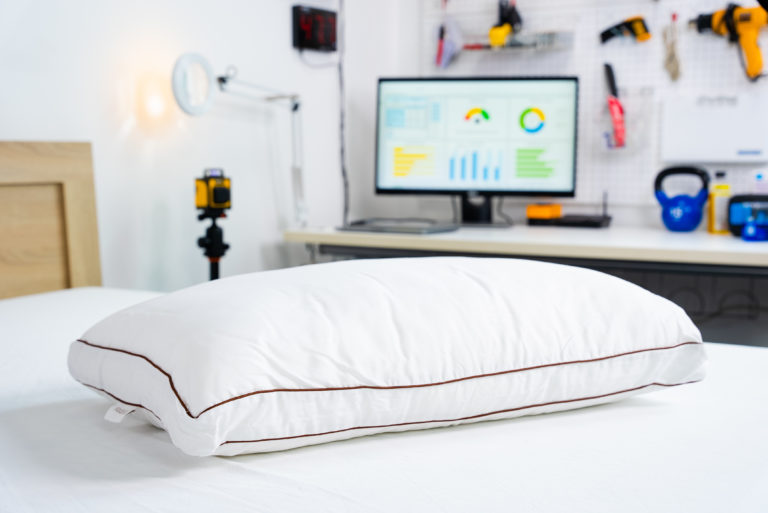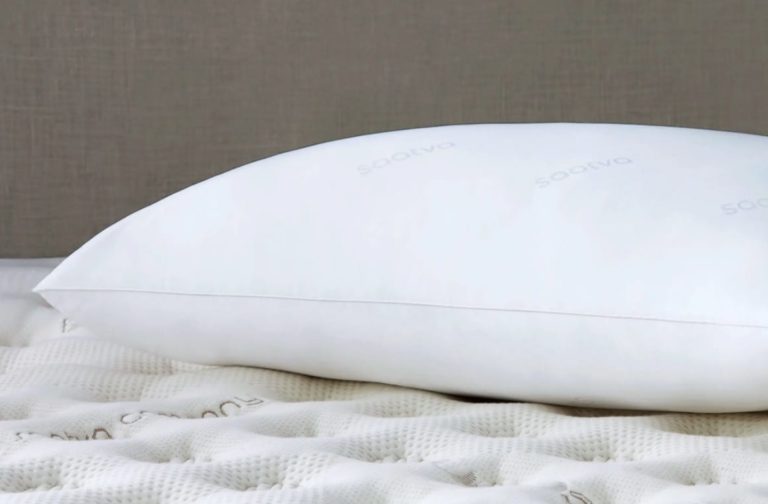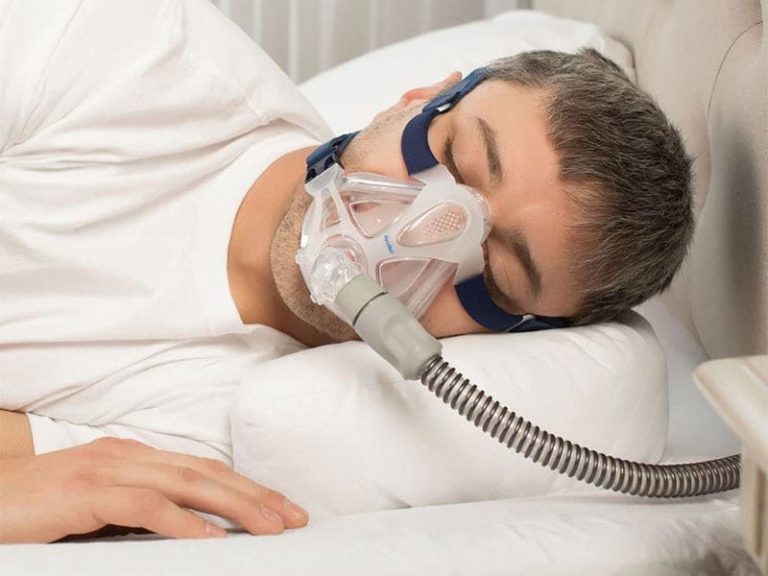When you buy through our links, we may earn a commission. Products or services may be offered by an affiliated entity. Learn more.
Sleep apnea is a common sleep disorder that may affect as many as one in four adults. For individuals suffering from obstructive sleep apnea, continuous positive airway pressure (CPAP) therapy can be an effective treatment.
When it comes to pillows, the best models for sleep apnea can improve both comfort and CPAP performance, often resulting in better quality sleep. Some pillow designs feature indents for CPAP masks and hoses, helping reduce the risk of face mask air leaks, while others are made to keep sleepers comfortable on their backs.
A pillow for sleep apnea may be beneficial, but it should always act as a complement to your existing care plan — not as a substitution for treatment. Here are our picks for the best pillows for people with sleep apnea.
Our Top Picks
-
Best Overall – cpaphero Hero CPAP Pillow
View Details
-
Best Wedge Pillow – Helix Wedge Pillow
View Details
-
Best Adjustable – Luxome LAYR Customizable Pillow
View Details
-
Best Cooling – Contour CPAPmax 2.0 Pillow
View Details
Swipe for more
Best Overall
cpaphero Hero CPAP Pillow
8.8 /10
Test Lab Score
The Hero CPAP Pillow comes to the rescue if nightly CPAP therapy is interfering with your sleep quality. Solid foam cut in an ergonomic shape creates a plush, soothing surface for your head and neck, and a cutout on each side prevents your mask’s connective tubing from becoming crimped or bent.

Credit: Sleep Foundation Test Lab
Price
$60
Fill
Solid memory foam
Firmness
Medium
Full Details
Many pillows are suitable for people with sleep apnea, but cpaphero’s Hero CPAP Pillow is one of the only models specifically designed for people who use CPAP therapy. Solid memory foam creates a cushy, supportive core, ensuring the pillow contours closely and evenly without losing shape. The ergonomic shape delivers extra support beneath your neck while cradling your head and shoulders — this is key for even spinal alignment if you’re a side sleeper.
Both sides of the pillow are recessed to provide space for your CPAP mask’s connective tubing. Whether you prefer sleeping on your left or right side, this thoughtful touch should prevent your hose from becoming crimped and tangled during the night. The cover is removable and fully machine-washable for quick, easy care.
The Hero CPAP Pillow is reasonably priced, given the high-quality design. If you reside in the contiguous U.S. and place your order through Sleep Doctor, you’ll also qualify for free ground shipping. Returns for unopened and unused pillows are permitted within 60 days of the delivery date.
Best Wedge Pillow
Helix Wedge Pillow
8.6 /10
Test Lab Score
Use this link for the most current Helix discounts
Use this link for the most current Helix discounts
People who snore excessively due to sleep apnea can benefit from the Helix Wedge Pillow, which elevates the head and neck to open the breathing passages. Solid foam construction ensures excellent overall support, and the poly-rayon cover is breathable enough to offset heat retention.

Price
$109
Fill
Gel Memory Foam and Polyfoam
Firmness
Medium Firm
Full Details
The Helix Wedge Pillow uses a classic triangular wedge design with a gradual slope. It is designed for a variety of applications, including reading in bed, reducing back pain, and reducing snoring. Some individuals find that using a wedge pillow for sleep apnea helps them get more restful sleep. Others simply enjoy the wedge shape for relaxing in bed. By lifting the upper body, wedge pillows may help to reduce airway compression caused by gravity.
Polyfoam and memory foam make up the body of the Helix Wedge Pillow to provide support while subtly contouring to the sleeper’s body. A gel infusion within the memory foam is designed to limit heat buildup. The cover is made of a polyester/rayon blend and is removable and machine washable.
The wedge shape of this pillow is well suited to back sleepers, although some side sleepers also enjoy this design. The medium-firm composition of the pillow also means that it holds its shape well and is appropriate for most individuals who weigh over 130 pounds.
The Helix Wedge Pillow is available in one size, measuring 24 inches by 24 inches by 10 inches. It comes with a 100-night sleep trial and is protected by a 1-year limited warranty.
Best for Side Sleepers
Bicor Products CPAP Pillow for Side Sleeping
7.4 /10
Test Lab Score
Use this link for the most current Bicor Products discounts
Use this link for the most current Bicor Products discounts
The Bicor Products CPAP Pillow for Side Sleepers delivers the plushness and loft needed to sleep comfortably in this position. Cutouts help ensure your connective tubing won’t get tangled or crimped during the night.
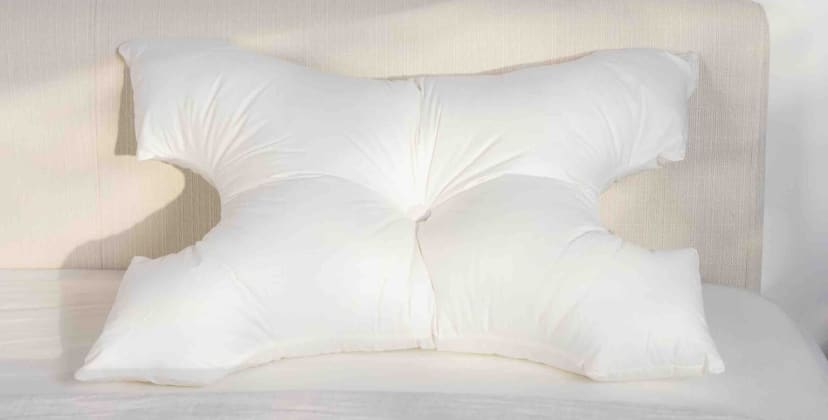
Credit: Sleep Foundation Test Lab
Price
$50
Fill
Down alternative fibers
Firmness
Medium
Full Details
If you’ve been diagnosed with sleep apnea, switching from sleeping on your back to the side position can alleviate some of the heavy snoring associated with this medical condition. In doing so, you may need a new pillow. Side sleepers require more pillow loft to fill the space between their head and downward-facing shoulder — otherwise poor alignment can occur and pain often follows.
The Bicor Products CPAP Pillow for Side Sleeping features a cutout design that specifically caters to this position. The deep cutouts on either side of the pillow create a space for your connective tubing, which helps prevent air leaks that can occur when conventionally shaped pillows bump against the hose. The pillow is also thick enough to fill the space between your head and downward-facing shoulder, with a dimple in the pillow’s center to cradle your head. This design minimizes potential for neck and shoulder pain.
The fill is made from 100% polyester down alternative fiber, which feels soft and fluffy. This material retains minimal heat, so hot sleepers should not experience any noticeable overheating. A shell composed of 50% cotton and 50% polyester encases the fill.
The CPAP Pillow for Side Sleeping carries a reasonable price-point. If you order on The Sleep Doctor, purchases under $99 incur a small shipping fee. The pillow ships free of charge anywhere in the contiguous U.S.
Best Adjustable
Luxome LAYR Customizable Pillow
9.1 /10
Test Lab Score
Use this link for the most current discount.
Use this link for the most current discount.
The Luxome LAYR comes with solid foam, shredded foam, and down alternative inserts to customize the loft and firmness. This adjustable design is particularly well suited to CPAP users who are combination sleepers.
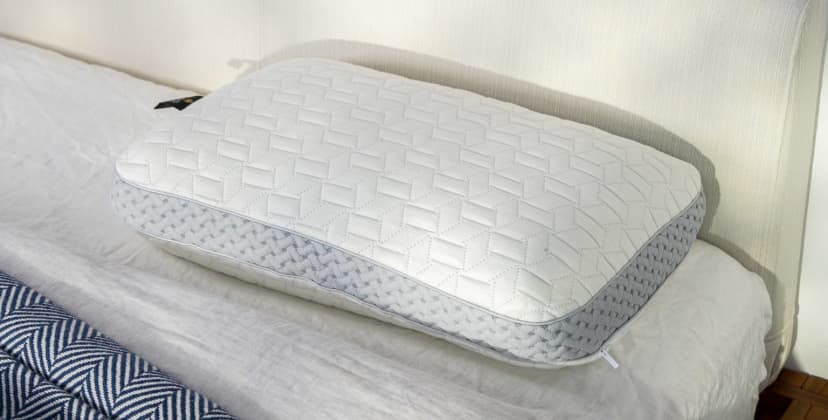

Credit: Sleep Foundation Test Lab
Price Range
$140 – $160
Fill
Down alternative, shredded gel-infused memory foam, and solid gel-infused memory foam
Firmness
Adjustable
Full Details
Luxome’s LAYR Customizable Pillow may not be a dedicated CPAP model like some of the other picks on this list, but the adjustable design helps ensure a comfortable night’s rest in any sleep position. Each pillow comes with four inserts, which you can add, remove, and rearrange to create a surface that aligns with your optimal loft and firmness levels. Although finding your ideal configuration may require some trial and error, we’re confident most people can sleep comfortably on the LAYR.
The first insert contains synthetic fibers meant to mimic the natural softness and lightness of real down. Placing this insert on top of the pillow adds plushness to the surface. The insert containing shredded memory foam is adaptive and squishy — we recommend this insert on top if you want the pillow to contour closely to your head and neck. Two additional inserts are made of solid memory foam and measure 1 and 2 inches thick, respectively. These inserts are ideal if you want firm support directly beneath your head, and also create a stable base for the other inserts.
Our tests show side sleepers should use at least three — and possibly all four — inserts to fill the space between their head and downward-facing shoulder. Otherwise, neck and shoulder pain is likely to occur. Most back sleepers on our team enjoyed the down alternative or shredded foam insert over one or both of the solid foam inserts. This creates a mid-range loft to ensure adequate support without any extra strain. Stomach sleepers will probably prefer one to two inserts.
A zippered cotton liner contains each insert, and the entire pillow is encased in an outer cover composed of bamboo-derived viscose. This cooling fabric excels at breathability and moisture control, and the side panel is ventilated for additional airflow while you sleep. You may wash and dry the liners and cover in your household machines. The LAYR is available in standard and king sizes.
Competitive pricing and free shipping for contiguous U.S. orders make the LAYR a solid choice for budget-conscious shoppers. Luxome also offers a 50% discount on the second pillow when you purchase two. Every order is backed by a 30-night trial period.
Best Cooling
Contour CPAPmax 2.0 Pillow
6.8 /10
Test Lab Score
Use this link for the most current Contour discounts
Use this link for the most current Contour discounts
Specifically designed for CPAP therapy, the Contour CPAPmax 2.0 features cutouts on each side to accommodate your face mask and a tether to keep your tubing connected. An adjustable design allows you to customize the firmness and loft to your liking.

Credit: Sleep Foundation Test Lab
Price
$60
Fill
Memory foam with fiber fill, support polyfoam
Firmness
Medium Firm
Full Details
Many pillows accommodate people with sleep apnea, but the CPAPMax Pillow 2.0 from Contour is specifically designed for those who treat this condition with CPAP therapy. Cutouts on each side allow more room for the hose linking your CPAP machine and face mask, and a tether attachment loops around your hose to ensure a secure connection throughout the night.
The pillow’s core contains three layers of solid memory foam, creating a plush and adaptive feel for close contouring around the head and neck. With all three layers intact, the pillow measures roughly 6 inches thick — an ideal loft for many side sleepers. If the pillow feels too tall, you can remove one or two of the layers and lower the profile. The cover is made of quilted mesh fabric that promotes airflow and helps the pillow stay cool. You may remove and machine wash the cover whenever it needs to be cleaned.
The CPAPMax Pillow 2.0 is reasonably priced and Contour offers free ground shipping for all orders within the contiguous U.S. You may return the pillow within 45 nights if you aren’t satisfied. If you decide to keep it, you’ll receive a 2-year warranty against structural and material defects.
Best Overall
cpaphero Hero CPAP Pillow
8.8 /10
Test Lab Score
A cushy, adaptive memory foam pillow specifically designed for people who receive CPAP therapy.
See More Details

Credit: Sleep Foundation Test Lab
Best Wedge Pillow
Helix Wedge Pillow
8.6 /10
Test Lab Score
Use this link for the most current Helix discounts
Shop at HelixA wedge pillow composed of dense foam that elevates the head and helps reduce snoring.
See More Details

Best for Side Sleepers
Bicor Products CPAP Pillow for Side Sleeping
7.4 /10
Test Lab Score
Use this link for the most current Bicor Products discounts
Shop at Sleep DoctorA supportive, hypoallergenic pillow with cutouts to prevent your CPAP tubing from bunching.
See More Details

Credit: Sleep Foundation Test Lab
Best Adjustable
Luxome LAYR Customizable Pillow
9.1 /10
Test Lab Score
Use this link for the most current discount.
Shop at LuxomeA customizable pillow that allows you to adjust the firmness, feel, and profile to meet your needs.
See More Details

Credit: Sleep Foundation Test Lab
Best Cooling
Contour CPAPmax 2.0 Pillow
6.8 /10
Test Lab Score
Use this link for the most current Contour discounts
Shop at Sleep DoctorA cushy pillow with adjustable loft and side cutouts to accommodate your CPAP tubing.
See More Details

Credit: Sleep Foundation Test Lab
How to Choose a Pillow for Sleep Apnea
The pillow you choose will affect your comfort and quality of rest. For CPAP users, a quality model can reduce the frequency of mask air leaks and uncomfortable pressure on the face. Factors such as support, pressure relief, loft, and firmness all affect the overall performance of a pillow, so shoppers should carefully consider them. For those with sleep apnea, aspects such as contouring, pillow shape, and CPAP-specific design features should also be kept in mind.
What to Consider When Purchasing a Sleep Apnea Pillow
The following criteria can influence the performance, comfort, and quality of a pillow, so they’re worth assessing when shopping for new pillows. There are many pillow options on the market, but sleepers can easily narrow down their options by focusing on the factors that are most important for those with sleep apnea.
Sleeping Position
Sleeping position has a substantial effect on pillow performance, particularly for CPAP users. Side and stomach sleepers often experience pressure from their mask pushing into the pillow, which can cause both discomfort and air leaks. Those who sleep on their side or stomach may benefit from a CPAP pillow with indents or cutouts to accommodate their mask, while back sleepers can also utilize cervical and wedge pillow designs.
Shape
The shape of a pillow and how well it retains its shape are important considerations for those with sleep apnea. Side sleepers often prefer contoured designs, which can comfortably accommodate the shoulders and neck. Specialty shapes, such as wedge pillows and CPAP pillows, are also worth considering for certain sleepers. CPAP pillows allow space for the mask and hose, making them popular with side and stomach sleepers, while wedge pillows elevate the upper body, which may appeal to back sleepers.
“Side sleepers tend to need a high-loft pillow for support and to fill the space beneath the head and neck to promote proper spinal alignment. Keep your head and neck in alignment at around 30 degrees with the help of a good pillow so your airway stays open during the night, allowing air to flow from your nose to your lungs without obstruction.”
– Sarah Silverman, Psy.D., a licensed psychologist and holistic sleep wellness consultant who treats patients in New York and Florida.
Mask Accommodation
Many of the best pillows for CPAP users feature design elements intended to accommodate CPAP masks and hoses. Generally, this includes indented areas of the pillow which give extra room for face masks. It may also include grooves that the tubing can rest in. This factor is most important for side and stomach sleepers and for any CPAP user who has experienced trouble with mask seal or comfort in the past.
Loft
Loft refers to the height of the pillow. It influences the angle of the head and neck, which can affect spinal alignment, ease of breathing, comfort, and more. Some pillows have an adjustable loft, allowing sleepers to add or remove material to achieve their desired comfort level. Stomach sleepers tend to prefer low-loft pillows, back sleepers medium-loft, and side sleepers high-loft.
Support
Support measures how well the pillow holds up the neck and head and keeps the spine aligned. Some materials, like polyfoam and memory foam, tend to be more supportive than others.
Firmness Level
Firmness is measured on a scale of very soft to very firm. Personal comfort preferences, sleeping position, and bodyweight can all influence the desired firmness level for each sleeper. The best firmness for a sleeper typically balances support and contouring to promote spinal alignment while providing comfort.
Pressure Relief
Depending on their designs, pillows can either relieve pressure or create pressure points. A pillow’s loft, materials, and firmness level, combined with sleeping position, all contribute to a pillow’s pressure relief performance. Some specialty designs have specific features intended to relieve pressure on the neck. In the case of cervical pillows, a small indent is found in the center of the pillow, cradling the head and reducing pressure on the neck.
Price
Pillows can be found in a range of price-points. Quality pillows for sleep apnea will generally be found in the $50 to $150 range. The best values are often competitively priced models with high-quality materials and design features since they balance quality and affordability.
Quality Materials
Pillows can be made with a variety of materials, although most for sleep apnea use memory foam. There are varying levels of quality within each category of materials. Regardless of the type of material, high-quality components typically enhance the pillow’s comfort, performance, and durability.
Temperature Regulation
Some pillows trap warmth more than others. For sleepers who tend to overheat at night, a pillow’s temperature-regulating properties are an important consideration. Memory foam tends to sleep warmer than many materials. However, these models often contain cooling design features intended to combat heat retention, like gel infusions or perforations for better airflow.
What Types of Pillows Are Best for Sleep Apnea?
There are many different pillow styles, each with distinct pros and cons. Pillows can differ in shape, style, materials, and firmness levels. Finding the option that works best for you depends on your personal preference and sleep position. As for sleep apnea pillows, there are a few categories that are generally best.
CPAP Pillow: CPAP pillows are specifically designed to accommodate CPAP masks. They generally feature indented areas on both edges of the pillow, which leave space for bulky full-face masks and/or tubes. These pillows are well suited to side and stomach sleepers who need the extra space to accommodate their mask, although back sleepers may find that they are too lofty.
Wedge Pillow: Wedge pillows feature a sloped design that helps to elevate the upper body in bed. They are commonly used for lounging in bed while reading or watching TV, but some sleepers also find them useful for sleeping. Their elevation can reduce airway compression and may also help to minimize snoring.
Cervical Pillow: Cervical pillows are ergonomically designed and primarily intended for back sleepers. They are engineered to relieve pressure on the neck, often featuring an indent in the center of the pillow intended to cradle the head. Sleep apnea patients who are combination sleepers or back sleepers may benefit from cervical pillows.
Standard Pillow: Standard pillows are generally filled with down, feathers, down alternative, or foam. They have a standard rectangular shape, are widely available, and are generally inexpensive. However, they do not offer any features specifically designed for the needs of those with sleep apnea.
Take Our Quiz to Know Your Sleep Apnea Risk
To understand if you could have sleep apnea, take our short quiz below to see if you exhibit any signs.
Tips for Getting Better Rest With Sleep Apnea
Choosing the right pillow can help those with sleep apnea get better rest, but there are many other factors worth exploring. In addition to practicing good sleep hygiene and finding the best mattress to meet their individual needs, there are some practices that those with sleep apnea should pay close attention to.
Using a CPAP Properly
For those who have been prescribed CPAP therapy, using the machine nightly is very important. Various small steps can help improve the efficacy of the machine, including ensuring the mask fits properly and washing your face before putting on the mask.
Cleaning CPAP Components
Ensuring that the CPAP components are cleaned frequently is important for safety, sleep quality, and general hygiene. CPAP masks, in particular, require frequent cleaning in order to reduce the buildup of body oils. A clean CPAP mask will provide a tighter seal, reducing the risk of air leaks.
Working With a Doctor
Sleep apnea is a long-term condition for many sleepers, and its severity can change over time. Family doctors and sleep specialists can tailor recommendations to each patient. For example, they may customize pressure settings on CPAP units based on your needs. Patients should make appointments with a sleep specialist every few years, particularly if sleep issues arise.
Maintaining a Healthy Weight
Bodyweight can have a substantial impact on the severity of sleep apnea symptoms. Excess weight, particularly near the throat, can cause airway restriction and other breathing issues.
Adding Humidification
Many modern CPAP units have built-in humidification. For those who do not use a heated humidifier, it may be worth trying. Humidifiers help keep the nasal passage moist, potentially reducing irritation and congestion and improving CPAP performance.
Altering Sleeping Positions
Trying out different sleep positions may be worthwhile for those struggling with sleep apnea. Some individuals experience reduced sleep apnea symptoms while on their sides. Others prefer back sleeping, as it allows for the most comfortable fit for CPAP masks.
Lifestyle Changes
Various lifestyle changes, including reducing alcohol consumption, increasing aerobic exercise, and cutting back on smoking can all have an effect on sleep quality for those with sleep apnea.
Frequently Asked Questions
Does sleeping with the head elevated help sleep apnea?
Some individuals with sleep apnea find that sleeping with their head elevated does improve sleep quality. A study published in 2017 found that a slight elevation of the upper body “significantly improves OSA severity without interfering in sleep architecture”. This sleeping position can be achieved with the help of a wedge pillow for sleep apnea or an adjustable bed.
Does sleeping on a wedge help with sleep apnea?
Sleeping on a wedge may help with sleep apnea. As referenced above, one study found that sleep apnea patients sleeping with their head elevated slightly (7.5 degrees) experienced improved sleep quality.
Does sleeping without a pillow help sleep apnea?
Sleeping without a pillow is unlikely to improve sleep apnea severity. In fact, it is likely to jeopardize the spinal alignment of side and back sleepers, potentially putting more pressure on the airway. However, stomach sleeping may be beneficial for those with sleep apnea, and many individuals who favor this position sleep without a pillow to avoid forcing the head backward.
Do sleep apnea pillows really work?
Some pillows may help certain individuals get better sleep. Finding the right pillow is a highly individualized process, so there is no way to know with certainty whether a specific pillow will work for you. If you’re struggling to rest comfortably with sleep apnea, you should talk to your doctor. Not only can they provide a treatment plan, but they may also be able to suggest what type of sleep apnea pillow may be best for your condition.

Still have questions? Ask our community!
Join our Sleep Care Community — a trusted hub of product specialists, sleep health professionals, and people just like you. Whether you’re searching for the perfect mattress or need expert sleep advice, we’ve got you covered. Get personalized guidance from the experts who know sleep best.


